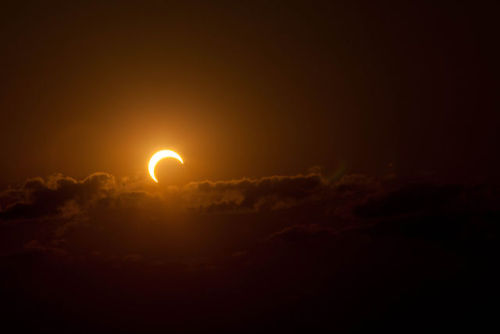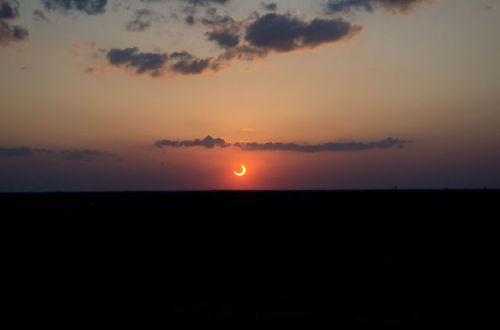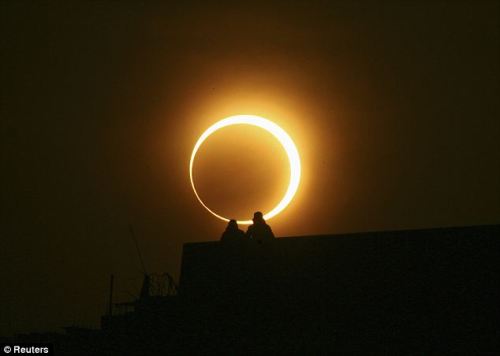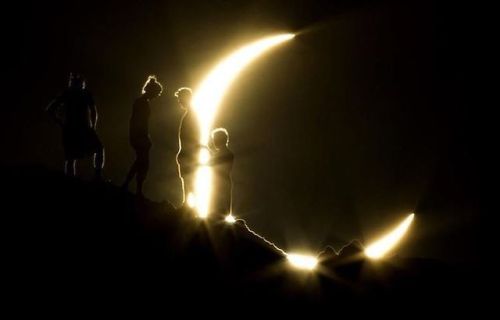It Made It!
It made it!

Thank you SpaceX. You just gave us the keys to our dreams. So much is now possible…
(Image credit: SpaceX SES-10 stream)
More Posts from Fillthevoid-with-space and Others









A ‘Ring of Fire’ solar eclipse is a rare phenomenon that occurs when the moon’s orbit is at its apogee: the part of its orbit farthest away from the Earth. Because the moon is so far away, it seems smaller than normal to the human eye. The result is that the moon doesn't entirely block out our view of the sun, but leaves an “annulus,” or ring of sunlight glowing around it. Hence the term “annular” eclipse rather than a “total” eclipse.

Spacewalk complete and new astronaut record set! Shane Kimbrough and Peggy Whitson of NASA successfully reconnected cables and electrical connections on an adapter-3 that will provide the pressurized interface between the station and the second of two international docking adapters to be delivered to the complex to support the dockings of U.S. commercial crew spacecraft in the future. The duo were also tasked with installing four thermal protection shields on the Tranquility module of the International Space Station.
Having completed her eighth spacewalk, Whitson now holds the record for the most spacewalks and accumulated time spacewalking by a female astronaut. Spacewalkers have now spent a total of 1,243 hours and 42 minutes outside the station during 199 spacewalks in support of assembly and maintenance of the orbiting laboratory.
Astronaut Thomas Pesquet of ESA posted this image and wrote, ’ Shane and Peggy on their way to their first #spacewalk tasks.’
Credit: ESA/NASA

An episode late is better than none at all! Hear about satellites, space probes, orbiters, and landers through history.
Below the cut are sources, music credits, an awesome infographic showing all the satellites currently in orbit around Earth, a vocab list, and the transcript of this episode. Let me know what you think I should research next by messaging me here, tweeting at me at @HDandtheVoid, or asking me to my face if you know me in real life. And please check out the podcast on iTunes, rate it or review it if you’d like, subscribe, and maybe tell your friends about it if you think they’d like to listen!
(My thoughts on the next episode were space race history, the transit of Venus, or maybe something about the Moon landing. I’m prepping to interview a friend about her graduate-level research into the history of the universe and possibly dark matter, too. Let me know by the 8th and I’ll hopefully have the next podcast up on September 18th!)
Glossary
Clarke Belt - an area of geostationary orbit in Earth’s atmosphere, 35,786 km directly above the equator, where a satellite orbits the Earth at the same speed the Earth is rotating.
geostationary orbit - when an object orbits directly above the equator and appears stationary to observers on Earth’s surface.
geosynchronous orbit - when an object orbits Earth at an orbital period that matches Earth's rotation on its axis. From the perspective of an observer on Earth's surface, the object would return to the exact same position in the sky after a period of one day.
gyroscopes - a device consisting of several rings that spin freely around different axes. The rapidly rotating wheel has a large moment of inertia and therefore resists change from the plane in which it is rotated. Large gyroscopes allow for steady navigation of ships, submarines, and space ships. See examples in the link.
heliosheath - the outer region of the heliosphere. It is just beyond termination shock, the point where solar wind abruptly slows down and becomes denser and hotter as it presses outward against the approaching wind in interstellar space.
heliosphere - a huge wind sock-shaped bubble that extends beyond Pluto’s orbit and contains our solar system, solar wind, and the entire solar magnetic field.
lander - a spacecraft launched with the intent to land it, unharmed and fully functioning, on the surface of an object that is astronomical in nature. It is aimed at a specific target that astronomers want to learn more about and investigates the object at the surface level. It can be manned or unmanned.
orbiter - an unmanned spacecraft launched with the intent to bring it into orbit around a larger body in order to study that body. It is similar to a satellite but does not orbit Earth.
probe - an unmanned machine sent into space to collect data. It is aimed at a specific target that astronomers want to learn more about.
spacecraft - a pilot-able vehicle used for traveling in space. It can be manned or unmanned.
Van Allen Belts - belts of radiation in Earth’s atmosphere.
Transcript
Sources
Timeline of space exploration to 2013 via the National Archives
Timeline of NASA, the space shuttle, and near-Earth space flights
Space exploration timeline via Sea and Sky
Gyroscope definition via USC
Infographic on satellites launched 1950-1978 via the CalTech Jet Propulsion Lab
List of satellites via Wikipedia
A history of Sputnik via an excerpt from Paul Dickson’s book Sputnik: The Shock of the Century on PBS
“Instead of being concerned with winning the first round of the space race, Eisenhower and his National Security Council were much more interested in launching surveillance satellites that could tell American intelligence where every Soviet missile was located.”
Explorer 1 overview via NASA
Vanguard 1 overview via NASA
SCORE overview via the Smithsonian National Air and Space Museum
Pioneer lunar mission overview via the CalTech Jet Propulsion Lab
Various probe/satellite mission overviews via NASA
Australian WRESAT mission via Australia’s Department of Defence
Pioneer expeditions via NASA
Mariner 10 mission overview via NASA
Magellan mission overview via NASA
Synthetic aperture radar overview via radartutorial.edu
MESSENGER mission overview via JHU Applied Physics Lab
Mariner missions to Venus overview via the CalTech Jet Propulsion Lab
Mariner missions to Mars overview via the CalTech Jet Propulsion Lab
“The final Mariner to Mars, however, was the lab’s greatest planetary success to date.”
Mariner 9 via the CalTech Jet Propulsion Lab
Viking mission overview via NASA
Pathfinder/Sojourner mission overview via NASA
Opportunity mission overview via the CalTech Jet Propulsion Lab
Spirit mission overview via the CalTech Jet Propulsion Lab
Curiosity rover via NASA
Pioneer 10 mission overview via NASA
Pioneer 11 mission overview via NASA
Juno mission overview via the CalTech Jet Propulsion Lab
Cassini-Huygens mission overview via the CalTech Jet Propulsion Lab
Voyager mission overview via the CalTech Jet Propulsion Lab
“The Voyager message is carried by a phonograph record, a 12-inch gold-plated copper disk containing sounds and images selected to portray the diversity of life and culture on Earth.”
Voyager mission trackers via the CalTech Jet Propulsion Lab
Heliosphere definition via NASA
Heliosheath definition via NASA
New Horizons mission overview via NASA
Compton Gamma-Ray Observatory via NASA
Chandra X-Ray Observatory via NASA
Spitzer Space Telescope via CalTech
Einstein Observatory (HEAO-2) via NASA
International Ultraviolet Explorer (IUE) via NASA
International Ultraviolet Explorer (IUE) via ESA
Extreme Ultraviolet Explorer (EUVE) via NASA
Advanced Satellite for Cosmology and Astrophysics (ASCA, formerly ASTRO-D) via NASA archives
Far Ultraviolet Spectroscopic Explorer (FUSE) via JHU
Active space probe/observatory missions via NASA
Chandrayaan-1 via the CalTech Jet Propulsion Lab
Hayabusa 2 mission overview via NASA
Hayabusa-2’s twitter account
A map of every active satellite orbiting Earth via Quartz
Union of Concerned Scientists Satellite Database
Cul-de-Sac comic by Richard Thompson
“Well, there’s dust everywhere, and there’s all kinds of trash—food wrappers and broken parts of things and gloves and shoes. And gas giants and black holes and rocks and dirt. And there’s old TV shows and strange creatures and there’s unidentifiable stuff that no one can explain. And it’s expanding all the time. Toss in a few trillion stuffed toys and it’d be just like your room.”
Intro Music: ‘Better Times Will Come’ by No Luck Club off their album Prosperity
Filler Music: ‘Satellite’ by Guster off their album Ganging Up On The Sun
Filler Music: ‘Sunn’ by Radical Face off his album Sunn Moonn Eclippse. Check out the video in the album link, it’s amazing.
Outro Music: ‘Fields of Russia’ by Mutefish off their album On Draught.
Heads up, this is tomorrow night! I hope it's clear where I am to see it but considering I'm in the Pacific Northwest, I don't have super high hopes. Get a look if you can, though! Rare to see a blue moon that's actually red :)
A Total Lunar Eclipse is Coming: 10 Things to Know
If you were captivated by August’s total solar eclipse, there’s another sky show to look forward to on Jan. 31: a total lunar eclipse!

Below are 10 things to know about this astronomical event, including where to see it, why it turns the Moon into a deep red color and more…
1. First things first. What’s the difference between solar and lunar eclipses? We’ve got the quick and easy explanation in this video:
2. Location, location, location. What you see will depend on where you are. The total lunar eclipse will favor the western U.S., Alaska, Hawaii, and British Columbia on Jan. 31. Australia and the Pacific Ocean are also well placed to see a major portion of the eclipse, if not all of it.

3. Color play. So, why does the Moon turn red during a lunar eclipse? Here’s your answer:
4. Scientists, stand by. What science can be done during a lunar eclipse? Find out HERE.
5. Show and tell. What would Earth look like from the Moon during a lunar eclipse? See for yourself with this artist’s concept HERE.
6. Ask me anything. Mark your calendars to learn more about the Moon during our our Reddit AMA happening Monday, Jan. 29, from 3-4 pm EST/12-1 pm PST.

7. Social cues. Make sure to follow @NASAMoon and @LRO_NASA for all of the latest Moon news leading up to the eclipse and beyond.
8. Watch year-round. Can’t get enough of observing the Moon? Make a DIY Moon Phases Calendar and Calculator that will keep all of the dates and times for the year’s moon phases right at your fingertips HERE.

Then, jot down notes and record your own illustrations of the Moon with a Moon observation journal, available to download and print from moon.nasa.gov.
9. Lesson learned. For educators, pique your students’ curiosities about the lunar eclipse with this Teachable Moment HERE.
10. Coming attraction. There will be one more lunar eclipse this year on July 27, 2018. But you might need your passport—it will only be visible from central Africa and central Asia. The next lunar eclipse that can be seen all over the U.S. will be on Jan. 21, 2019. It won’t be a blue moon, but it will be a supermoon.
Make sure to follow us on Tumblr for your regular dose of space: http://nasa.tumblr.com.
I'm reading Starlight Detectives pretty hard cuz new episode goes up on Monday and let me tell you, I now have a very deep appreciation for the photographs we have of space.

Small Magellanic Cloud: Stunning Infrared Image
For the love of all that’s good and proper click here and zoom way into this image. It’s more than beautiful. The fact that it’s infrared means that we’re able to see past a lot of the dust that would otherwise block our view.
(Image credit: ESA/VISTA)


This is a Trichroic Beam Splitter.
Using this splitter a white beam of light can be separated into three colours. Red, Blue and Green.
Source

Where to look, and when.
I found a bizarre open-access, peer-review journal of STEM research. It was hard for me to find anything that pertained to astronomy or any of the stellar studies, but I did find a couple categories I could investigate:
Astrobiology
Astronomical Sciences
Spectroscopy (I didn’t see any astronomical spectroscopy stuff but who knows)
Just looking at the articles popping up suggests that it would take some serious digging to find anything (and I would certainly have to work on my keyword optimization techniques because typing ‘space’ into the search bar got me nothing relevant to my interests), but it’s a new potential resource! And for anyone who wants to find a way to publish in STEM fields, maybe it’s something worth checking out?

Yes, sure its fun to see a lady spin around like that, but I had one of my friends ask me - “Where do you even use this mate?”
Here’s one application that I know very well off.
Spin Stabilization
If you have ever seen a rocket launch, you might know that sometimes the rockets are given a spin while launching. This is known as spin stabilization.

Basically, the rotational inertia of the rotating body will stabilize the rocket against any disturbances and help maintain its intended heading.
The same principle is used in rifling of firearms as well. **

YoYo DeSpin
Okay, now there is the question how to “De-spin” the rocket:
Well, you do what the lady does: stretch out your arms and you will slow down !

The rocket has weights connected to a cable that stretch out and almost immediately the rocket slows down. This maneuver is known as the YoYo DeSpin. ( Damn good name ! )
All thanks to the conservation of angular momentum !
Have a good one !
* Another method to stabilization : 3-axis stabilization
** Bullets spin stabilization - post
** Source rocket launch video



Of Course I Still Love You returned to Port Canaveral earlier this morning with the SES-10 Falcon 9 first stage. Since this is the first Falcon 9 rocket to be reflown this marks the second time this particular rocket returned to port after landing. The images above were captured by remote cameras on the droneship and show the vehicle coming into land. Falcon 9 landed eight minutes after a March 30 liftoff from LC-39A at Kennedy Space Center. Extensive scorching is visible on the exterior of the rocket including the interstage and grid fins. The fins themselves were seen glowing during launch footage as the booster returned to Earth. Each fin is coated in ablative paint which helps protect the metal but the severe temperatures of reentry still cause the fins to glow. Since SES-10 was placed into Geostationary Transfer Orbit, not enough propellant remained in the first stage’s tanks to allow for a nominal reentry profile and the boostback burn was not performed. As such, the rocket came in over twice its normal landing speed and eight times hotter than flights which have a boostback burn. This particular rocket will not be reused after recovery; Elon Musk stated in the SES-10 post-launch news conference that the rocket will likely be given to the Air Force for display at either Cape Canaveral or Kennedy Space Center. P/C: SpaceX
-
 girl-gone-international- liked this · 7 years ago
girl-gone-international- liked this · 7 years ago -
 filippsworld liked this · 8 years ago
filippsworld liked this · 8 years ago -
 arrowwhiskers reblogged this · 8 years ago
arrowwhiskers reblogged this · 8 years ago -
 blackberryoatmilk reblogged this · 8 years ago
blackberryoatmilk reblogged this · 8 years ago -
 blackberryoatmilk liked this · 8 years ago
blackberryoatmilk liked this · 8 years ago -
 rebeccadt liked this · 8 years ago
rebeccadt liked this · 8 years ago -
 dsnoopyzi-blog reblogged this · 8 years ago
dsnoopyzi-blog reblogged this · 8 years ago -
 dsnoopyzi-blog liked this · 8 years ago
dsnoopyzi-blog liked this · 8 years ago -
 cactuscollectordrum liked this · 8 years ago
cactuscollectordrum liked this · 8 years ago -
 bitsofsoul liked this · 8 years ago
bitsofsoul liked this · 8 years ago -
 lntellectually reblogged this · 8 years ago
lntellectually reblogged this · 8 years ago -
 runawayteenspirit reblogged this · 8 years ago
runawayteenspirit reblogged this · 8 years ago -
 t-rexdescendant liked this · 8 years ago
t-rexdescendant liked this · 8 years ago -
 dungeonsynths reblogged this · 8 years ago
dungeonsynths reblogged this · 8 years ago -
 spacient reblogged this · 8 years ago
spacient reblogged this · 8 years ago -
 charlottephillips-blog1 liked this · 8 years ago
charlottephillips-blog1 liked this · 8 years ago -
 anaranesindanarie liked this · 8 years ago
anaranesindanarie liked this · 8 years ago -
 l-i-l-i-th liked this · 8 years ago
l-i-l-i-th liked this · 8 years ago -
 andromeda1023 reblogged this · 8 years ago
andromeda1023 reblogged this · 8 years ago -
 andromeda1023 liked this · 8 years ago
andromeda1023 liked this · 8 years ago -
 shpeep-blog liked this · 8 years ago
shpeep-blog liked this · 8 years ago -
 keaneedham liked this · 8 years ago
keaneedham liked this · 8 years ago -
 running-to-the-tardis liked this · 8 years ago
running-to-the-tardis liked this · 8 years ago -
 footnoteinhistory liked this · 8 years ago
footnoteinhistory liked this · 8 years ago -
 poszukiwaczwrazencysia15-blog liked this · 8 years ago
poszukiwaczwrazencysia15-blog liked this · 8 years ago -
 angeluscore liked this · 8 years ago
angeluscore liked this · 8 years ago -
 andr0meda-666 liked this · 8 years ago
andr0meda-666 liked this · 8 years ago -
 thepurposewithin reblogged this · 8 years ago
thepurposewithin reblogged this · 8 years ago -
 thepurposewithin liked this · 8 years ago
thepurposewithin liked this · 8 years ago -
 zandalorzero liked this · 8 years ago
zandalorzero liked this · 8 years ago -
 ambitiousasshat liked this · 8 years ago
ambitiousasshat liked this · 8 years ago -
 fredsvariety reblogged this · 8 years ago
fredsvariety reblogged this · 8 years ago -
 azhurae liked this · 8 years ago
azhurae liked this · 8 years ago -
 doyourememberwalter liked this · 8 years ago
doyourememberwalter liked this · 8 years ago -
 nai21things liked this · 8 years ago
nai21things liked this · 8 years ago -
 courtney-avery liked this · 8 years ago
courtney-avery liked this · 8 years ago -
 celebratechibi liked this · 8 years ago
celebratechibi liked this · 8 years ago
A podcast project to fill the space in my heart and my time that used to be filled with academic research. In 2018, that space gets filled with... MORE SPACE! Cheerfully researched, painstakingly edited, informal as hell, definitely worth everyone's time.
243 posts